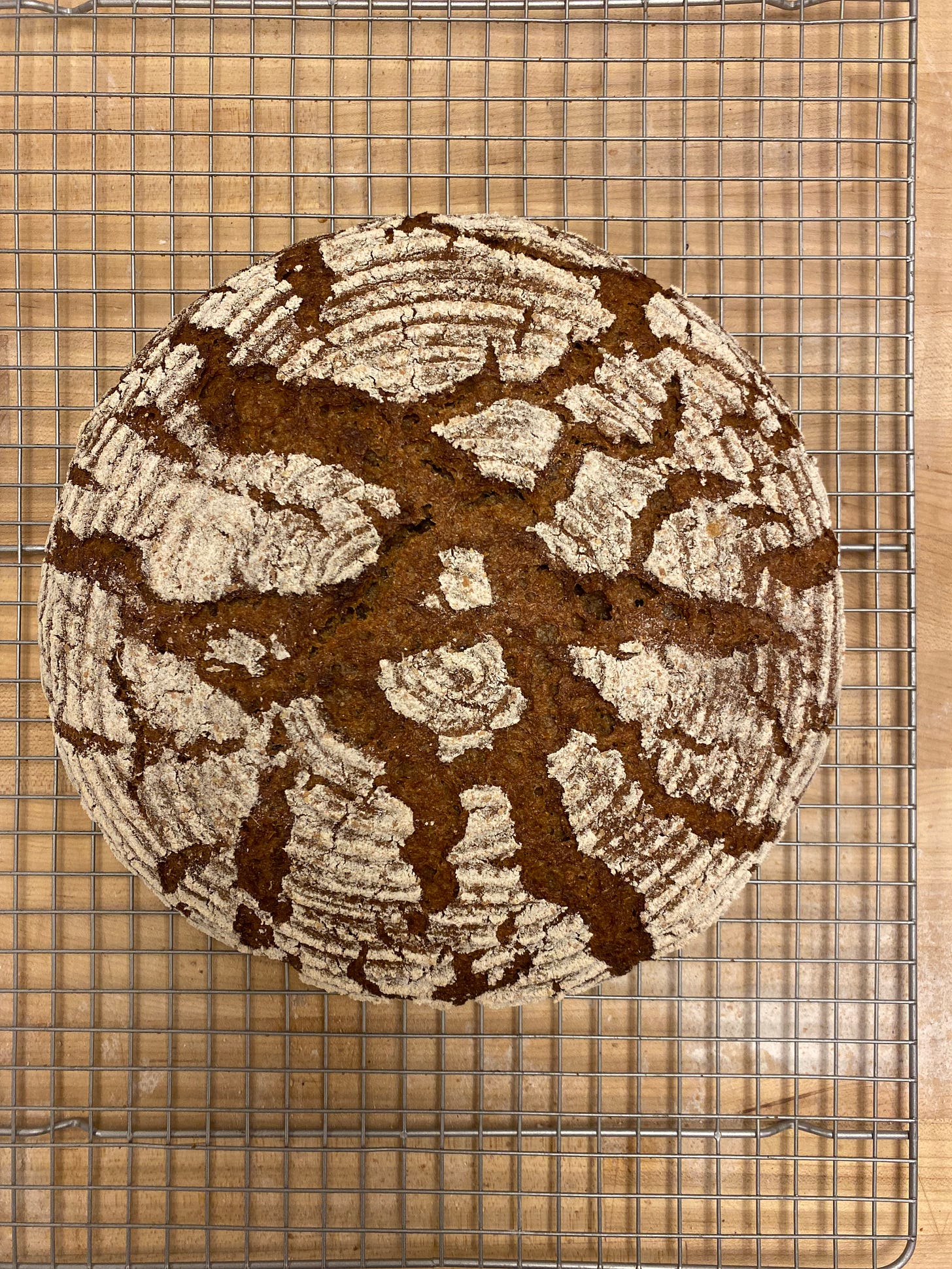This one starts off as a bit of a rant. Bare with me.
Wholegrain flour is healthy, sourdough improves that.
White flour isn’t nearly as nutritious as wholegrain flour, sourdough doesn’t change that.
Sourdough is a natural process that humans discovered thousands of years ago, along with nixtamalization, so that our bodies can absorb the nutrients in the grains we eat. Sourdough isn’t special on it’s own. The sourdough process allows the 21 micronutrients in wholegrain to be bioavailable (absorbable). Phytic acid bonds nutrients together and prevents the body from being able to absorb them. Phytase is an enzyme that breaks down phytic acid, and occurs naturally during the fermentation process making those nutrients like iron, B and E vitamins, folic acid, to be absorbable. It’s this enzymatic activity that allows grain to sustain human life, and has brought civilization to where it is today. The ambient yeasts and bacteria in sourdough culture isn’t what is being consumed for healthy gut flora. It is the grain that has been altered during fermentation that is making us healthy, and providing the flavour. But if it’s not wholegrain there are not any nutrients for this process to make available.
This piece below is something I wrote a few months ago and was never sure what to do with. I think it fits here just fine.
Wholegrain Immersion
I can’t stand white flour. It’s not that I see it as garbage, but I see it as the product of garbage. Whatever reason it exists, and was created to begin with, doesn’t suit or reflect our current needs as consumers and food producers. Oftentimes, over-sifting is taking place. So we are not just discarding the germ and bran, we are polishing the endosperm before we turn it into flour. To make white flour, we are discarding more than twenty percent of the grain. One fifth of our crops are being wasted. That one fifth, made mostly of germ and bran, contains 20 of the 21 micronutrients found in wheat. White flour is missing 95% of the micronutrients contained in wholegrain wheat flour. What is wrong with us? Isn’t it obvious how wrong this is? It’s so wrong, that big mills have been legally forced to enrich white flour with some of the nutrients they took (sifted) out. It is a loophole that small artisan mills are being allowed to make unenriched white flour. Eating wholegrains benefits the consumer because it tastes better and is nutrient rich. Socially, wholegrains support farmers and agriculture by valuing the entire crop and by providing the community with the most nutrient-rich food we can. Environmentally, it means we’re not using water to grow food just to throw it out. The waste the conventional system creates has no regard for the real impact it has on people, our community, and the environment. The most valuable part of the grain can’t be seen as a by-product. Animal feed and compost aren’t good enough recipients. And although you can make delicious things with just bran and germ, nothing is better than having it milled whole, and never sifted to begin with. Sourdough bread is best with wholegrain flour. Believe me, the microbes agree. And if it’s not about the microbes, why sourdough to begin with? Even people making sourdough bread with white flour love talking about the digestion benefits of sourdough, a gut-friendly food. During the fermentation process, an enzyme called phytase is created, and it breaks down the acid that bonds nutrients together and prevents them from being digestible. Much less important when the nutrient-rich germ and bran weren’t included in the first place, let alone any of the fiber. How can bread without nutrients or fiber be sold as healthy food? For sourdough bread to be nutritious, it has to be wholegrain. For the bran and germ to be most valuable to us, they have to be part of sourdough bread. Not all consumers and bakers are ready to embrace the practice of baking and eating the entire kernal, but I am. I am ready to give people access to the best wholegrain baking I can provide. Using the wholegrain allows me to bring the most flavourful product to market, with the highest nutrient content and lowest carbon footprint.
I don’t want each of these newsletters to be rants or diatribes. But I wanted to make sure I gave clear reasons to why I approach baking the way I do, why I believe it has to be wholegrain. I once wrote a piece under the criteria of a “flavour mutiny manifesto”. I’m sure you could guess the subject of mutiny I chose.
In my next letter I will write a little bit more about the goings-on in Vancouver, trying to find a location for a bakery, and about my trip to the WSU Bread Lab.
Lastly, because a few people have brought it up, I just wanted to clarify that the content of this newsletter is free. The subscription option is only offered as a way to financially contribute towards me starting a bakery early on, before any other ways become available. There will be other fundraising opportunities in the future in the forms of pop-ups and a crowd-funding campaign. So, please feel free to choose a paid subscription if you’re looking for ways to get involved, but feel no pressure. More than anything, I am so grateful for your interest and engagement. Photo below is a bread from Stanley Ginsberg’s book The Rye Baker. Austrian Country Boule, made at WSU BreadLab with Laura Valli.
Talk to you soon!




enjoyed this a lot. thank you for sharing a lot about wholegrain and nutrition!